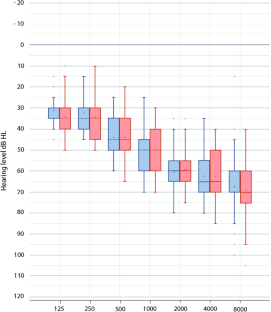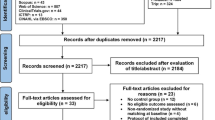Abstract
Purpose
The primary aim of this research study is to assess whether differences exist in the application of the NAL-NL2 and DSL v.5 prescription formulas in terms of speech-in-noise intelligibility.
Methods
Data from 43 patients, were retrospectively evaluated and analyzed. Inclusion criteria were patients with bilateral conductive, sensorineural, or mixed hearing loss, already using hearing aids for at least 1 year, and aged 18 years or older. Patients were categorized into two groups based on the prescriptive method employed by the hearing aid: NAL-NL2 or DSL v.5. Pure tone audiometry, speech audiometry, free field pure tone and speech audiometry with the hearing aid, and Matrix sentence test were performed. The Abbreviated Profile of Hearing Aid Benefit (APHAB) questionnaire was used to assess the personal audiological benefit provided by the hearing aid.
Results
No statistically significant differences were found comparing the free-field pure tone average (FF PTA) and the free-field Word Recognition Score (FF WRS). Comparing the Speech Reception Threshold (SRT) parameter of patients with NAL-NL2 vs DSL v.5, no statistically significant difference was found, thus highlighting a condition of comparability between the two prescription methods in terms of speech-in-noise intelligibility. Comparing the results of the APHAB questionnaire, no statistically significant differences were evident for all subscales and overall benefit. When conducting a comparison between male and female patients using the NAL-NL2 method, no differences were observed in SRT values, however, the APHAB questionnaire revealed a difference in the AV subscale score for the same subjects.
Conclusion
Our analysis revealed no statistically significant differences in speech-in-noise intelligibility, as measured by the SRT values from the Matrix Sentence Test, when comparing the two prescriptive methods. This compelling result reinforces the notion that, functionally, both methods are comparably effective in enhancing speech intelligibility in real-world, noisy environments. However, it is crucial to underscore that the absence of differences does not diminish the importance of considering individual patient needs and preferences in the selection of a prescriptive method.

Similar content being viewed by others
Availability of data and materials
All data of the study are available on request to the corresponding author.
References
World Health Organization (2021) World report on hearing. World Health Organization, Geneva
Kamogashira T, Fujimoto C, Yamasoba T (2015) Reactive oxygen species, apoptosis, and mitochondrial dysfunction in hearing loss. Biomed Res Int 2015:1–7. https://doi.org/10.1155/2015/617207
Almufarrij I, Dillon H, Munro KJ (2022) Do we need audiogram-based prescriptions? A systematic review. Int J Audiol 62:500–511. https://doi.org/10.1080/14992027.2022.2064925
Kollmeier B, Kiessling J (2016) Functionality of hearing aids: state-of-the-art and future model-based solutions. Int J Audiol 57:S3–S28. https://doi.org/10.1080/14992027.2016.1256504
Keidser G, Dillon HR, Flax M et al (2011) The NAL-NL2 prescription procedure. Audiol Res 1:e24. https://doi.org/10.4081/audiores.2011.e24
Scollie S, Seewald R, Cornelisse L et al (2005) The desired sensation level multistage input/output algorithm. Trends Amplif 9:159–197. https://doi.org/10.1177/108471380500900403
Bruno R, Freni F, Portelli D et al (2020) Frequency-lowering processing to improve speech-in-noise intelligibility in patients with age-related hearing loss. Eur Arch Otorhinolaryngol 278:3697–3706. https://doi.org/10.1007/s00405-020-06431-8
Turrini M, Cutugno F, Maturi P et al (1993) Bisyllabic words for speech audiometry: a new italian material. Acta Otorhinolaryngol Ital 13:63–77
Puglisi GE, Warzybok A, Hochmuth S et al (2015) An Italian matrix sentence test for the evaluation of speech intelligibility in noise. Int J Audiol 54:44–50. https://doi.org/10.3109/14992027.2015.1061709
Kollmeier B, Warzybok A, Hochmuth S et al (2015) The multilingual matrix test: principles, applications, and comparison across languages—a review. Int J Audiol 54:3–16. https://doi.org/10.3109/14992027.2015.1020971
Portelli D, Ciodaro F, Loteta S et al (2023) Audiological assessment with Matrix sentence test of percutaneous vs transcutaneous bone-anchored hearing aids: a pilot study. Eur Arch Otorhinolaryngol 280:4065–4072. https://doi.org/10.1007/s00405-023-07918-w
Gazia F, Portelli D, Lo Vano M et al (2022) Extended wear hearing aids: a comparative, pilot study. Eur Arch Otorhinolaryngol 279:5415–5422. https://doi.org/10.1007/s00405-022-07445-0
Gazia F, Galletti B, Portelli D et al (2020) Real ear measurement (REM) and auditory performances with open, tulip and double closed dome in patients using hearing aids. Eur Arch Otorhinolaryngol 277:1289–1295. https://doi.org/10.1007/s00405-020-05822-1
Cox RM, Alexander GC (1995) The abbreviated profile of hearing aid benefit. Ear Hear 16:176–186. https://doi.org/10.1097/00003446-199504000-00005
Almufarrij I, Dillon H, Munro KJ (2021) Does probe-tube verification of real-ear hearing aid amplification characteristics improve outcomes in adults? A systematic review and meta-analysis. Trends Hear 25:2331216521999563. https://doi.org/10.1177/2331216521999563
Smeds K, Keidser G, Zakis JA et al (2006) Preferred overall loudness. II: Listening through hearing aids in field and laboratory tests. Int J Audiol 45:12–25. https://doi.org/10.1080/14992020500190177
Mueller GH (2005) Fitting hearing aids to adults using prescriptive methods: an evidence-based review of effectiveness. J Am Acad Audiol 16:448–460. https://doi.org/10.3766/jaaa.16.7.5
Scollie S, Ching TYC, Seewald R et al (2010) Evaluation of the NAL-NL1 and DSL v4.1 prescriptions for children: preference in real world use. Int J Audiol 49:S49–S63. https://doi.org/10.3109/14992020903148038
Johnson E (2019) 20Q: Same or different—comparing the Latest NAL and DSL Earl Johnson. In: Audiology. https://www.audiologyonline.com/articles/20q-same-or-different-comparing-769. Accessed 8 Nov 2023
Acknowledgements
The study was conducted in collaboration with Widex Italia.
Funding
This research received no external funding.
Author information
Authors and Affiliations
Corresponding author
Ethics declarations
Ethical approval
The research adhered to the Declaration of Helsinki. This study represents a retrospective analysis of data obtained from our clinical practice and the protocol routinely applied by the center. All patients provided their consent for the use of personal data. Due to the non-invasiveness of the tests, the use of a standard hearing aids application protocol, and the retrospective nature of the analysis, no ethical committee approval was required for the study's execution.
Conflict of interest
The authors declare that there is no conflict of interest.
Additional information
Publisher's Note
Springer Nature remains neutral with regard to jurisdictional claims in published maps and institutional affiliations.
Rights and permissions
Springer Nature or its licensor (e.g. a society or other partner) holds exclusive rights to this article under a publishing agreement with the author(s) or other rightsholder(s); author self-archiving of the accepted manuscript version of this article is solely governed by the terms of such publishing agreement and applicable law.
About this article
Cite this article
Portelli, D., Loteta, S., Ciodaro, F. et al. Functional outcomes for speech-in-noise intelligibility of NAL-NL2 and DSL v.5 prescriptive fitting rules in hearing aid users. Eur Arch Otorhinolaryngol (2024). https://doi.org/10.1007/s00405-024-08587-z
Received:
Accepted:
Published:
DOI: https://doi.org/10.1007/s00405-024-08587-z



